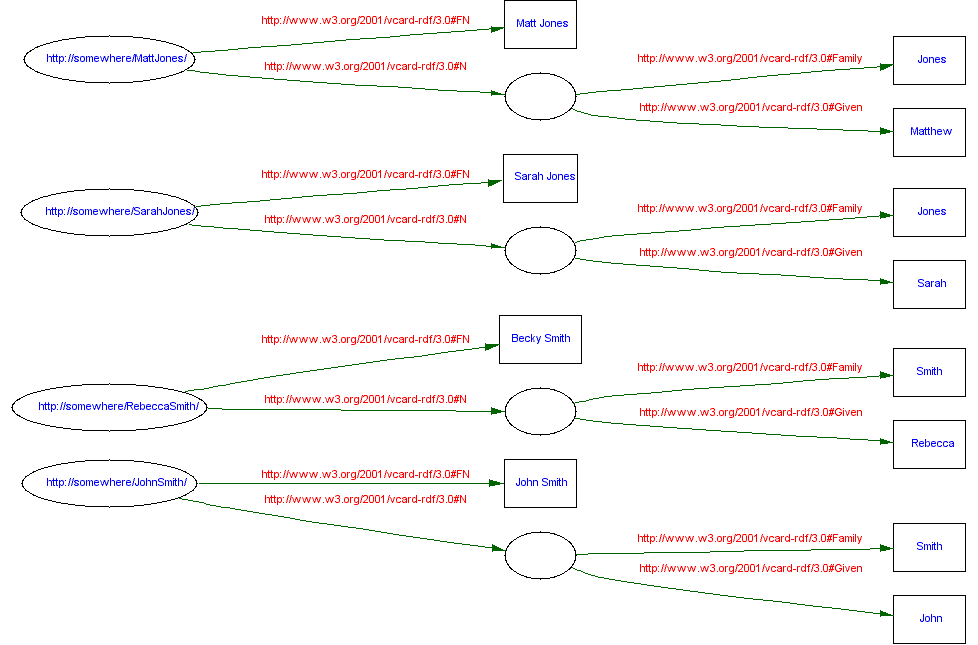
First, we need to be clear about what data is being queried. SPARQL queries RDF graphs. An RDF graph is a set of triples (Jena calls RDF graphs "models" and triples "statements" because that is what they were called at the time the Jena API was first designed).
It is important to realize that it is the triples that matter, not the serialization. The serialization is just a way to write the triples down. RDF/XML is the W3C recommendation but it can difficult to see the triples in this serialized becuae ethere are multiple ways to encode the same graph. In this tutorial, we use a more "triple-like" serialization, called Turtle (see also N3 languea described in the W3C semantic web primer).
We will start with the simple data in vc-db-1.rdf: this file contains RDF for a number of vCard descriptions of people. vCards are described in RFC2426 and the RDF translation is described in the W3C note "Representing vCard Objects in RDF/XML". Our example database just contains some name information.
Graphically, the data looks like (click to enlarge):
In triples, this might look like:
@prefix vCard: <http://www.w3.org/2001/vcard-rdf/3.0#> .
@prefix rdf: <http://www.w3.org/1999/02/22-rdf-syntax-ns#> .
@prefix : <#> .
<http://somewhere/MattJones/>
vCard:FN "Matt Jones" ;
vCard:N [ vCard:Family
"Jones" ;
vCard:Given
"Matthew"
] .
<http://somewhere/RebeccaSmith/>
vCard:FN "Becky Smith" ;
vCard:N [ vCard:Family
"Smith" ;
vCard:Given
"Rebecca"
] .
<http://somewhere/JohnSmith/>
vCard:FN "John Smith" ;
vCard:N [ vCard:Family
"Smith" ;
vCard:Given
"John"
] .
<http://somewhere/SarahJones/>
vCard:FN "Sarah Jones" ;
vCard:N [ vCard:Family
"Jones" ;
vCard:Given
"Sarah"
] .
or even more explicitly as triples:
@prefix vCard: <http://www.w3.org/2001/vcard-rdf/3.0#> . @prefix rdf: <http://www.w3.org/1999/02/22-rdf-syntax-ns#> . <http://somewhere/MattJones/> vCard:FN "Matt Jones" . <http://somewhere/MattJones/> vCard:N _:b0 . _:b0 vCard:Family "Jones" . _:b0 vCard:Given "Matthew" . <http://somewhere/RebeccaSmith/> vCard:FN "Becky Smith" . <http://somewhere/RebeccaSmith/> vCard:N _:b1 . _:b1 vCard:Family "Smith" . _:b1 vCard:Given "Rebecca" . <http://somewhere/JohnSmith/> vCard:FN "John Smith" . <http://somewhere/JohnSmith/> vCard:N _:b2 . _:b2 vCard:Family "Smith" . _:b2 vCard:Given "John" . <http://somewhere/SarahJones/> vCard:FN "Sarah Jones" . <http://somewhere/SarahJones/> vCard:N _:b3 . _:b3 vCard:Family "Jones" . _:b3 vCard:Given "Sarah" .
It is important to realize that these are the same RDF graph and that the triples in the graph are in no particular order. They are just written in related groups above for the human reader - the machine does not care.